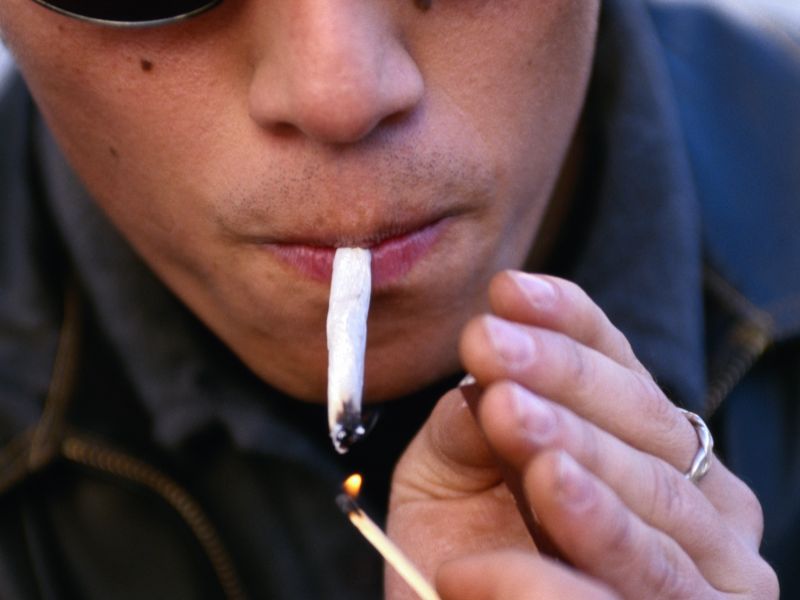
Thursday, October 15, 2015

THURSDAY, Oct. 15, 2015 (HealthDay News) -- While worried parents may take comfort in new statistics that show smoking among American teenagers has dropped 64 percent in recent years, the same report also shows that marijuana use has doubled.
And plenty of youngsters still light up. A full 30 percent of white, black and Hispanic teens smoked cigarettes, cigars or marijuana in 2013, according to the U.S. Centers for Disease Control and Prevention report. The researchers tracked teen smoking rates from 1997 to 2013.
"The nation's remarkable progress in reducing youth smoking since 1997 is great news, but the battle is far from over," said Vince Willmore, vice president for communications at Campaign for Tobacco-Free Kids.
"This study reminds us that we know exactly what to do to further reduce smoking: increase tobacco taxes, enact smoke-free laws, fund effective prevention programs and implement hard-hitting mass media campaigns. These proven strategies must be continued and strengthened," Willmore added.
The researchers also called for targeted prevention programs and policies that involve parents, schools, communities and the media.
Overall, the number of teens who smoked cigarettes or cigars dropped from 20.5 percent to slightly more than 7 percent, while marijuana use went from 4 percent to 10 percent, the report found.
Notably, marijuana use jumped from 51 percent to 62 percent among those teens who smoked cigarettes or cigars, the findings showed.
By 2013, black and Hispanic students made up a considerable percentage of the increase in marijuana use, the investigators found. From 2009 to 2013, marijuana use among black teens increased from just under 11 percent to nearly 17 percent, while it jumped from 8.5 percent to just over 14 percent among Hispanic teens.
"Thus, public health advances in adolescent health resulting from lower cigarette and cigar use might be attenuated by increases in marijuana use, which vary by racial/ethnic subgroup," the CDC researchers, led by Italia Rolle, wrote in their report.
Dr. Tim McAfee, director of CDC's Office on Smoking and Health, believes that more acceptance of marijuana as a harmless drug is driving its increased use among teens.
"Over the last 10 or 15 years, there has been a change in public perception of marijuana," he said. "There is the idea that marijuana is not something you need to worry about."
Because marijuana has been illegal, little is known about its long-term effects, McAfee added. "There has not been an effort [to conduct research] about the downside to marijuana use," he said.
However, one of the downsides is its negative effect on the developing adolescent brain, McAfee said. And some teens can become dependent on it, he added.
In addition, unlike cigarettes, no tobacco-like media campaigns are telling kids not to use marijuana, McAfee pointed out. "Nothing is being done," he said.
The report was published Oct. 16 in the CDC's Morbidity and Mortality Weekly Report (MMWR).
In another report in the same issue of the MMWR, researchers led by S. Rene Lavinghouze found that, across the United States, more people are trying to break the smoking habit. The number of smokers who tried to quit in the past year increased significantly in 29 states and the U.S. Virgin Islands.
From 2011 to 2013, the proportion of smokers who tried to quit increased in Hawaii and Puerto Rico, but decreased in New Mexico. In 2013, the number of smokers who tried to stop ranged from 56 percent in Kentucky to 76 percent in Puerto Rico and Guam, the report showed.
The researchers urge continued use of anti-smoking programs to reach the Healthy People 2020 target of 80 percent or more of smokers who made an attempt to quit in the past year.
"These interventions include increasing the price of tobacco products, implementing comprehensive smoke-free laws, conducting educational mass media campaigns and providing insurance coverage for all effective cessation treatments, as well as access to quit-lines," Lavinghouze and colleagues wrote.
SOURCES: Tim McAfee, M.D., director, Office on Smoking and Health, U.S. Centers for Disease Control and Prevention; Vince Willmore, vice president, communications, Campaign for Tobacco-Free Kids, Washington, D.C.; Oct. 16, 2015, Morbidity and Mortality Weekly Report
HealthDay
Copyright (c) 2015 HealthDay. All rights reserved.
- More Health News on:
- Marijuana
- Quitting Smoking
- Smoking and Youth








































No hay comentarios:
Publicar un comentario